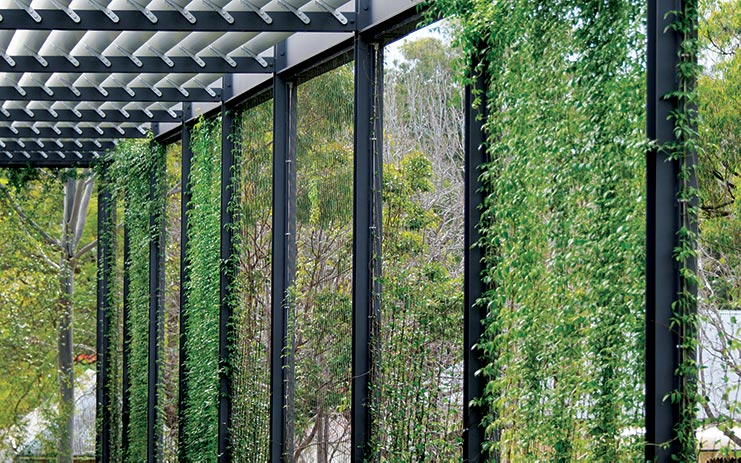
Designing a successful green wall or cable trellis comes down to planning, and the careful consideration of the function and purpose the structure is to serve. Is the objective of the wall to provide visual screening or to achieve a reduction in thermal gain? Is attracting wildlife important? Different plants and trellis systems achieve different results in terms of plant growth and benefits. For example, choosing deciduous plants provides good shading and control of thermal gain, but may not provide the desired lush visual screen during the winter months. Careful consideration of the purpose, and the desired attributes and benefits of your greening structure will serve as a guide in choosing the right plants and design of the support structure. This will provide a base from which you can measure the success of your green wall project.
Climate generally determines which plant species exist naturally within an environment. Paying close attention to the species already flourishing in the vicinity of the intended green wall or trellis, provides a good indicator of plant species likely to grow well.
The orientation of the green wall is important for determining sun exposure and wind speed. When considering the orientation of the green wall, it is also important to note surrounding structures likely to affect the amount of sunlight and wind speed to which the green wall is exposed. Once the orientation is determined, it is best to match the hours of sunlight the area receives during the day with species that cope well in these conditions. This can be done with a light meter or through simple observation and reference to our Plant Selection Guide.
A common cause of failure for green facades is the incorrect design of the planter units. Quite simply, plants need room for their roots to expand as they grow. If the planter is too small, it is unlikely the plant will achieve its maximum mass.
Important aspects of planter design include:
Climbing Habit
A. Self Clinging
Self clinging plants can attach themselves to relatively smooth surfaces and because of this, they do not require any trellis to support their growth; however, they are notorious for causing damage to building facades as their roots can grow into small cracks in the surface.
e.g. Ivy, Trumpet Vine
B. Tendril Climbers
The tendrils are specialised stem, leaf or petiole with a threadlike shape that is used by the plants for support and attachment. Unlike vines, they impart less load on to the mating structure. e.g. Clematis, Passionfruit
C. Vines (Twining Plants)
Vines twine around their supports as a result of the circular growth motion of their stem tips. They form a much stronger connection than tendril climbers and are better suited for high wind locations. e.g. Wisteria, Star Jasmine
D. Scrambling Plants
Scrambling plants work their way up by using epidermal outgrowth such as thorns. e.g. Bougainvillea, Climbing Roses
Plant Life Cycle
Deciduous – Deciduous climbers are ideal for thermal control as they provide shade in the summer and allow the sun through to heat the facade in winter. e.g. Ornamental Grape (Vitis Vinifera)
Evergreens – Evergreens maintain their foliage year round and can grow into a perfect privacy screen. e.g. Chinese Star Jasmine (trachelospermum jasminoides)
Growth Rate & Vigour
Plants have different growth rates. Some grow slowly during their early growth stages, taking longer to achieve the desired level of plant coverage. In this case the selection of mature plants may be an option. Other plants, with faster growth rates, may achieve the desired plant coverage quicker, but be wary as this can mean a considerable increase in ongoing maintenance to keep the plants under control.
Access to the green wall or trellis should be considered for both the initial installation as well as for regular general maintenance. A failure to consider the cost of appropriate access and labour to facilitate maintenance can lead to neglect and a less than satisfactory coverage.
It is important to ensure that whatever you are attaching the trellis structure to can support the loads which the trellis system will impose. The factors which need to be taken into account are:
The need for proper engineering of the trellis or mating structure should be evaluated on a case by case basis depending on the risk profile or possible outcomes of a structural failure.
At the very least, some thought must be given to consideration of the factors mentioned above.
Buildings are not natural environments for plants and human intervention is required to help them survive. As such, maintenance requirements should be considered carefully when evaluating the feasibility of a green wall project. Although clever design and technology can be used to reduce the need for maintenance (i.e. automated planter box irrigation systems), maintenance is unavoidable and the effectiveness of the regime will impact on the success of the project.